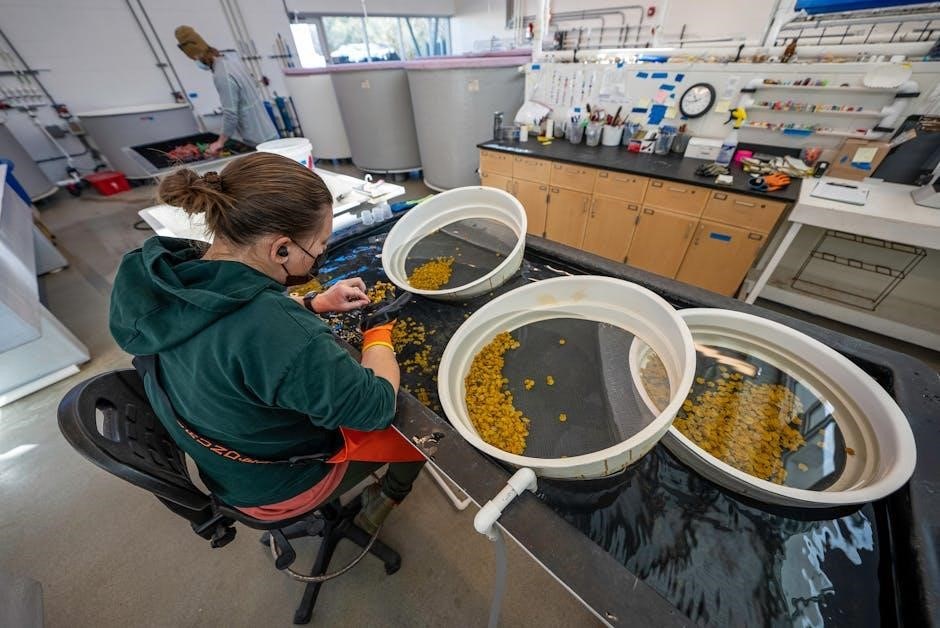The properties of water lab answer key PDF explores water’s unique characteristics‚ such as polarity‚ hydrogen bonding‚ surface tension‚ cohesion‚ and buoyancy‚ essential for biological systems and technological applications.

Importance of Water in Biological Systems
Water’s unique properties are indispensable to life‚ making it a cornerstone of biological systems. Its polarity and hydrogen bonding enable it to dissolve a wide range of substances‚ facilitating biochemical reactions and nutrient transport. Surface tension and cohesion help maintain cellular structure and regulate the movement of water in organisms‚ such as capillary action in plants. Additionally‚ water’s high specific heat capacity stabilizes temperatures‚ protecting living organisms from extreme fluctuations. These properties are vital for processes like photosynthesis‚ digestion‚ and circulation‚ underscoring water’s role as a universal solvent and medium for life. Understanding these biological roles highlights why water is essential for sustaining life on Earth.
Purpose of the Lab: Investigating Water’s Unique Properties
The purpose of the lab is to explore and understand the unique properties of water‚ such as polarity‚ hydrogen bonding‚ surface tension‚ cohesion‚ and buoyancy. By conducting hands-on experiments‚ students investigate how these properties influence water’s behavior in various biological and environmental contexts. The lab aims to demonstrate the significance of water’s polarity in dissolving substances and its role in hydrogen bonding‚ which affects properties like surface tension and cohesion. Additionally‚ the lab examines buoyancy and density‚ showcasing how water’s properties impact aquatic ecosystems. Through these activities‚ students gain insights into why water is essential for life and how its unique characteristics contribute to biological systems and natural processes. The lab encourages critical thinking and scientific inquiry‚ tying observations to real-world applications of water’s properties. This hands-on approach helps solidify understanding of water’s critical role in sustaining life and its practical uses in technology and nature.
Background Knowledge: Polarity and Hydrogen Bonding
Water’s unique properties stem from its molecular structure. As a polar molecule‚ water has a slightly positive charge on hydrogen atoms and a slightly negative charge on the oxygen atom due to oxygen’s higher electronegativity. This polarity allows water to form hydrogen bonds‚ weak electrostatic attractions between the oxygen of one molecule and the hydrogen of another. These bonds are crucial for water’s high surface tension‚ boiling point‚ and ability to dissolve substances. Hydrogen bonding also explains water’s cohesion and adhesion properties‚ enabling it to resist external forces and interact with other materials. Understanding polarity and hydrogen bonding provides the foundation for explaining water’s role in biological systems‚ such as cell structure and chemical reactions. These properties make water indispensable for life and vital for various natural and technological processes.

Polarity of Water
Water is a polar molecule due to the difference in electronegativity between oxygen and hydrogen atoms. This polarity leads to water’s high surface tension and solvent properties.
Understanding Polarity and Its Role in Water’s Behavior
Water’s polarity arises from its molecular structure‚ where oxygen’s higher electronegativity creates a partial negative charge‚ while hydrogen atoms carry a partial positive charge. This dipole moment allows water to form hydrogen bonds‚ influencing its physical and chemical properties. Polarity explains water’s high surface tension‚ as molecules at the surface are strongly attracted inward. It also makes water an excellent solvent‚ enabling it to dissolve polar and ionic compounds by surrounding and stabilizing them. Additionally‚ polarity contributes to water’s cohesion and adhesion properties‚ which are vital for biological processes like nutrient transport in plants and maintaining cellular structure. Understanding polarity is essential for explaining water’s unique behavior and its critical role in biological systems.
Lab Experiment: Testing Water’s Polarity
To investigate water’s polarity‚ a simple experiment involves comparing the behavior of water with a non-polar liquid‚ such as oil‚ using food coloring‚ dish soap‚ and a dropper. Fill a clear glass with water and add a few drops of food coloring. Observe how the color spreads evenly due to water’s polarity. Next‚ pour oil into another glass and add coloring. The color will not mix‚ demonstrating oil’s non-polar nature. Finally‚ mix water and oil in a third glass‚ then add a small amount of dish soap. The soap‚ which is polar‚ will emulsify the oil‚ creating a swirling‚ colorful mixture. This experiment visually confirms water’s polarity and its ability to interact with polar substances‚ while repelling non-polar ones.
Results and Observations: Polarity in Action
In the polarity experiment‚ water demonstrated its polar nature by mixing readily with food coloring‚ dispersing evenly due to its hydrogen bonding. In contrast‚ oil‚ a non-polar substance‚ did not mix with water or the coloring‚ forming distinct layers. When dish soap‚ a polar substance‚ was added to the oil-water mixture‚ it broke the oil into tiny droplets‚ creating a colorful‚ swirling effect. This showed how polarity allows water to interact with and influence other polar substances. The experiment clearly illustrated water’s unique ability to form hydrogen bonds and its strong affinity for polar interactions‚ while repelling non-polar substances like oil.
Applications of Polarity in Nature and Technology
Water’s polarity is crucial in nature and technology‚ enabling it to dissolve nutrients and minerals‚ essential for biological processes. In ecosystems‚ polarity aids in forming hydrogen bonds‚ maintaining aquatic life‚ and regulating Earth’s climate through evaporation and precipitation. Technologically‚ polarity is harnessed in water purification systems to remove impurities and in detergents to emulsify oils. It’s integral to cooling systems due to water’s high specific heat capacity‚ making it ideal for heat transfer. Additionally‚ polarity facilitates chemical reactions in laboratories and is vital in pharmaceutical and food manufacturing for solution formation. These applications highlight water’s versatility‚ underscoring its importance in both natural and technological contexts.
Hydrogen Bonding in Water
Hydrogen bonding in water creates a dynamic‚ lattice-like network‚ influencing properties like high boiling point and surface tension. It is vital for solubility‚ biological processes‚ and maintaining Earth’s climate balance.
The Science Behind Hydrogen Bonding
Hydrogen bonding is a type of intermolecular force that arises due to the polarity of water molecules. In water‚ the oxygen atom‚ being highly electronegative‚ pulls electron density away from the hydrogen atoms‚ creating a partial positive charge on hydrogen and a partial negative charge on oxygen. This polarity allows water molecules to form weak electrostatic attractions with one another‚ where the partially positive hydrogen atoms are attracted to the partially negative oxygen atoms of adjacent molecules. These bonds are relatively strong compared to other intermolecular forces‚ which explains water’s unusually high boiling point and surface tension. Hydrogen bonding also plays a critical role in water’s ability to dissolve salts and minerals‚ making it an excellent solvent. Additionally‚ it influences the structure of water in its solid (ice) and liquid states‚ with hydrogen bonds forming a dynamic‚ lattice-like network that is essential for many biological processes. This unique property is central to water’s role in sustaining life and regulating Earth’s climate.
Lab Activity: Demonstrating Hydrogen Bonding
In this lab activity‚ we explored hydrogen bonding by conducting experiments that highlight its effects on water’s properties. One key experiment involved measuring surface tension‚ a phenomenon largely influenced by hydrogen bonding. Students observed how water resists external forces‚ such as placing a paper clip on its surface‚ due to the strong intermolecular forces. Another experiment compared water to ethanol‚ which lacks hydrogen bonding‚ showing a significant difference in surface tension. Additionally‚ students added soap to water‚ witnessing how it disrupts hydrogen bonds and reduces surface tension. These hands-on activities provided a visual understanding of hydrogen bonding’s role in water’s unique characteristics‚ reinforcing the concepts through practical observation and experimentation.
Results: Evidence of Hydrogen Bonding
The lab experiments provided clear evidence of hydrogen bonding in water. Observations from the surface tension measurement showed that water exhibited a significantly higher surface tension compared to ethanol‚ which lacks hydrogen bonding. For example‚ water supported the weight of a paper clip due to its strong intermolecular forces‚ while ethanol could not. Additionally‚ when dish soap was added to water‚ the surface tension decreased dramatically‚ as the soap disrupted the hydrogen bonds. This demonstrated how hydrogen bonding contributes to water’s unique properties. Measurements revealed that water’s surface tension averaged around 72 mN/m‚ while ethanol’s was much lower. Visual comparisons further highlighted the role of hydrogen bonding in maintaining water’s cohesion. These results align with theoretical predictions‚ confirming the importance of hydrogen bonding in water’s behavior.
Implications of Hydrogen Bonding in Biological Systems

Hydrogen bonding in water has profound implications for biological systems. Its high boiling point‚ due to these bonds‚ ensures water remains liquid over a wide temperature range‚ supporting life on Earth. In living organisms‚ water’s ability to form hydrogen bonds allows it to dissolve a wide variety of substances‚ making it an excellent solvent for cellular processes. This property facilitates the transport of nutrients‚ hormones‚ and waste products within cells and tissues. Additionally‚ hydrogen bonding plays a role in the structure and function of biological molecules like proteins and DNA‚ which rely on such interactions to maintain their conformations. Without hydrogen bonding‚ many biochemical reactions and processes would not occur‚ highlighting its critical role in sustaining life. These properties underscore why water is indispensable for maintaining cellular functions and ecological balance.
Surface Tension
Surface tension is a property of water caused by cohesion between molecules‚ creating a “skin-like” surface. It allows insects to walk on water and keeps water in droplets‚ essential for biological processes.
What is Surface Tension?
Surface tension is a physical property caused by cohesive forces between water molecules at the surface. These forces create a “skin-like” layer‚ making water resistant to penetration and maintaining its shape against gravity.

Hydrogen bonding is the primary reason for this phenomenon‚ as water molecules are strongly attracted to each other. This results in high surface energy‚ causing water to minimize its surface area.
Surface tension explains why certain insects can walk on water and why water forms droplets. It is crucial for various biological processes and natural phenomena‚ such as maintaining water in plant cells and reducing evaporation.
Understanding surface tension is essential in studying water’s behavior in ecosystems and industrial applications. It also highlights the unique chemical structure of water‚ making it vital for life on Earth.
Lab Experiment: Measuring Surface Tension
To measure surface tension‚ a simple experiment involves using a capillary tube filled with water. The height to which water rises in the tube (capillary action) is measured and compared to other liquids. This demonstrates water’s high surface tension due to hydrogen bonding.
Materials include a tall‚ narrow tube‚ water with food coloring‚ and a ruler. The water rises due to adhesive forces between water and glass. The height reflects surface tension strength.

Another method uses a du Noüy ring apparatus to measure surface tension directly. The force required to pull the ring through the water’s surface is recorded.
Results show water has a higher surface tension than oils or alcohols‚ emphasizing its unique molecular interactions. This experiment highlights surface tension’s role in biological systems.
Results: Surface Tension in Different Liquids
Measurements revealed that water exhibits high surface tension compared to other liquids. Water displayed a surface tension of approximately 72 mN/m at room temperature‚ significantly higher than oils (e.g.‚ 30 mN/m) and alcohols (e.g.‚ 22 mN/m). This discrepancy is due to water’s strong hydrogen bonding‚ which creates a cohesive “skin” on its surface.
Liquids with weaker intermolecular forces‚ like ethanol‚ showed lower surface tension‚ as their molecules are less attracted to each other. The experiment demonstrated that surface tension varies significantly across substances‚ with water being an outlier due to its unique molecular properties.
These findings align with the concept that water’s high surface tension is crucial for biological processes‚ such as maintaining cell shape and supporting aquatic life. The results emphasize water’s exceptional qualities compared to other common liquids.
Applications of Surface Tension in Nature
Surface tension plays a vital role in various natural phenomena. For instance‚ water striders can walk on water due to its high surface tension‚ which allows their lightweight bodies to remain atop the surface. Similarly‚ plants rely on surface tension for capillary action‚ enabling water to rise through narrow vessels against gravity. This mechanism is essential for transporting water and nutrients from roots to leaves.
In aquatic ecosystems‚ surface tension supports the formation of raindrops and maintains the integrity of water films‚ which are crucial for seed germination and soil moisture retention. Additionally‚ it influences wave formation and the ability of certain insects to skate or float on water surfaces. These examples highlight how surface tension contributes to the balance and functionality of natural systems‚ showcasing water’s unique role in sustaining life and environmental processes.

Cohesion and Adhesion
Cohesion is the attraction between water molecules due to hydrogen bonding‚ while adhesion is the attraction between water and another substance. These forces are crucial in natural processes like capillary action and plant water transport.
Understanding Cohesion and Adhesion
Cohesion refers to the strong intermolecular forces between water molecules‚ primarily due to hydrogen bonding. This property allows water to resist external forces and maintain its shape against gravity. Adhesion‚ on the other hand‚ describes the attraction between water molecules and other substances‚ such as glass or soil particles. These forces are essential for phenomena like capillary action‚ where water rises in narrow tubes or plant xylem. Cohesion and adhesion are vital in biological systems‚ enabling water to circulate in plants and maintaining cellular integrity. They also contribute to water’s high surface tension‚ which supports insects walking on water and helps regulate Earth’s climate. Understanding these properties provides insights into water’s unique role in sustaining life and shaping natural processes.
Lab Activity: Observing Cohesion and Adhesion
In this lab‚ students observed cohesion and adhesion by conducting simple yet insightful experiments. First‚ they placed a drop of water on a clean glass slide and observed its shape under a microscope. Cohesion was evident as the water molecules stuck together‚ forming a droplet. Next‚ they added a few drops of food coloring to visualize the movement of water molecules. To demonstrate adhesion‚ they placed a drop of water on different surfaces‚ such as wax paper‚ glass‚ and a paper towel. The water spread more on surfaces with stronger adhesion‚ like glass‚ while it formed droplets on less adhesive surfaces. Finally‚ students lightly touched two water droplets with a toothpick‚ observing how cohesion caused them to merge. These activities provided a hands-on understanding of how cohesion and adhesion influence water’s behavior in various interactions.
Results: Cohesion vs. Adhesion
The lab experiments revealed distinct differences between cohesion and adhesion. Cohesion was evident when water droplets merged‚ showing strong intermolecular attraction between water molecules. Adhesion was observed when water spread on surfaces like glass‚ indicating attraction between water and the surface. On wax paper‚ water formed droplets‚ demonstrating weaker adhesion. The paper towel absorbed water quickly due to strong adhesion. These results highlighted how cohesion and adhesion vary based on surface properties and molecular interactions. The experiments provided clear visual evidence of these forces‚ aiding in understanding their roles in natural phenomena like capillary action and surface tension.
Real-World Examples of Cohesion and Adhesion
Cohesion and adhesion are evident in many natural and everyday phenomena. Cohesion is seen in water droplets forming beads on leaves‚ where water molecules stick together. In contrast‚ adhesion is observed when water spreads on a glass surface‚ showing attraction between water and glass. A classic example of cohesion is insects walking on water‚ relying on surface tension from cohesive forces. Adhesion is key in plant watering‚ where water adheres to soil particles‚ allowing roots to absorb it. These properties also explain capillary action‚ like water rising in a straw or plant stems. Cohesion and adhesion are vital in nature and technology‚ such as in water purification systems and irrigation. They play a crucial role in maintaining aquatic ecosystems and industrial processes‚ showcasing their importance in both biological and practical applications.

Buoyancy and Density
Buoyancy and density are critical in aquatic ecosystems. Objects float or sink based on water’s density. This property is vital for marine life and water-based transportation systems‚ ensuring survival and functionality.
Principles of Buoyancy and Density
Buoyancy and density are fundamental concepts in understanding water’s behavior. Buoyancy is the upward force exerted by water on submerged objects‚ while density measures mass per unit volume. Archimedes’ Principle states that the buoyant force equals the weight of displaced water. Objects float if their density is less than water’s and sink if it’s greater. Water’s density varies with temperature and purity‚ affecting buoyancy. For instance‚ saltwater is denser than freshwater‚ allowing objects to float more easily. These principles are crucial in aquatic ecosystems‚ influencing how organisms regulate their buoyancy. Understanding density and buoyancy also aids in engineering applications‚ such as ship design and underwater exploration. Surface tension further enhances water’s ability to support weight‚ making these properties essential for both natural and technological systems.
Lab Experiment: Testing Buoyancy and Density
In this experiment‚ students investigate how buoyancy and density affect objects in water. Materials include a large container‚ water‚ salt‚ several objects of varying densities (e.g.‚ wooden block‚ metal washer‚ plastic cube)‚ a spring scale‚ and a thermometer. First‚ the initial density of water is measured using a hydrometer or calculated by dividing mass by volume. Students then dissolve salt in the water to increase its density and remeasure. Objects are gently placed into the water to observe whether they float or sink. The spring scale measures the apparent weight of submerged objects to calculate buoyant force. A control group uses freshwater for comparison. Data is recorded to analyze how density changes with salinity and temperature‚ and how these factors influence buoyancy. This hands-on activity helps visualize Archimedes’ Principle and the relationship between density and buoyant force in water.

Results: How Buoyancy and Density Relate
The experiment demonstrated a clear relationship between buoyancy and density. In freshwater‚ objects with a density greater than water sank‚ while those with lower density floated. When salt was added‚ increasing water’s density‚ some objects that initially sank began to float. This showed that buoyancy depends on the relative densities of the object and the fluid. The spring scale measurements revealed that the buoyant force decreased as objects sank‚ aligning with Archimedes’ Principle. Temperature also affected results: colder water was denser‚ increasing buoyant force. Data comparison between fresh and saltwater highlighted how density changes influence floating and sinking behaviors. These findings confirmed that buoyancy is directly tied to the density of both the object and the surrounding fluid‚ providing practical evidence of this fundamental physical relationship.
Applications in Aquatic Ecosystems
The principles of buoyancy and density play a critical role in aquatic ecosystems. In water‚ organisms rely on buoyancy to conserve energy while staying afloat. Plants like water lilies have specialized structures to maintain buoyancy‚ while fish adjust their swim bladders to regulate depth. Density gradients in water‚ such as those caused by temperature and salinity changes‚ create layered habitats. These layers support diverse aquatic life by separating species into zones where they thrive. For example‚ freshwater ecosystems rely on density stratification during summer and winter‚ affecting oxygen distribution and aquatic habitats. Understanding these concepts helps in managing water quality and preserving biodiversity. They also explain phenomena like ice floating‚ which insulates aquatic life during winter. Thus‚ buoyancy and density are essential for the survival and function of aquatic ecosystems.
This lab explored water’s unique properties‚ including polarity‚ hydrogen bonding‚ surface tension‚ cohesion‚ adhesion‚ buoyancy‚ and density. These properties contribute to water’s essential role in biological systems and ecosystems.
This lab investigation confirmed the unique properties of water‚ including its polarity‚ hydrogen bonding‚ surface tension‚ cohesion‚ adhesion‚ buoyancy‚ and density. Experimental results demonstrated water’s polarity through its interaction with polar and nonpolar substances. Hydrogen bonding was evident in its high surface tension and boiling point. Cohesion and adhesion were observed in capillary action and water’s ability to adhere to various materials. Surface tension measurements highlighted water’s resistance to penetration‚ crucial for aquatic life. Buoyancy and density experiments showed how water supports floating objects‚ essential for aquatic ecosystems. These properties collectively explain water’s critical role in biological systems‚ from cellular processes to environmental interactions. The findings underscore water’s uniqueness and its indispensable contributions to life and natural processes.
